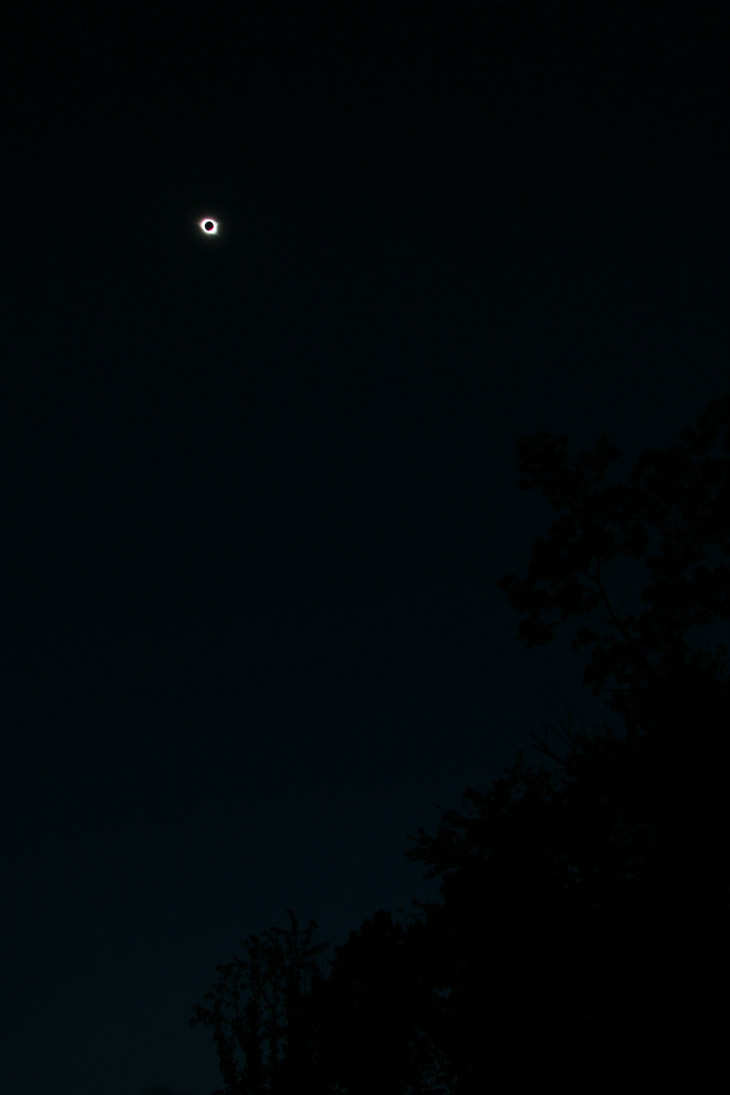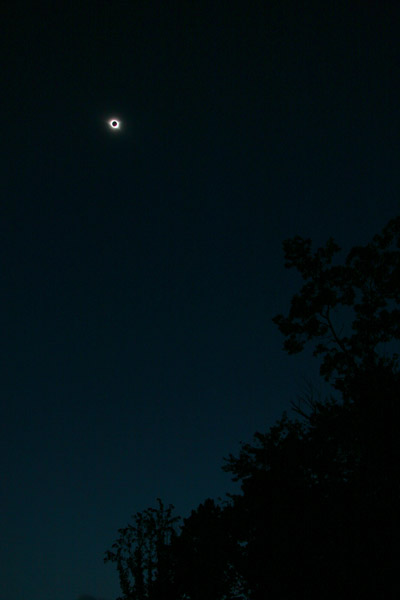
Another one that I had kicking around in my blog images folder, waiting for a chance to sit down and explain it – there’s a couple more coming too, but they’ll take a little longer to write up, so we’ll go with this for now. This was my attempt at a landscape shot during the total solar eclipse last year, which came out even worse than expected – but not a lot.
Let’s put it this way: you can, naturally, take any kind of landscape photo with the sun in the shot – but you’re not going to get one that also shows any sunspots. In order to see those, you’d need to reduce the light from the sun by a lot, a tiny fraction of its actual light output, and then the landscape would drop into total darkness. And the same thing’s going to happen during a solar eclipse. Even though the sun itself is blocked and thus you can see the corona, the sun is, you know, blocked, and the corona itself isn’t throwing enough light to illuminate the landscape around you. Sure, you can do a long exposure to actually get a view in the dim light, because after all it’s like late twilight; you can see where you’re walking and all that. But if you do that, the corona itself is going to bleach out and likely completely obscure the dark hole that communicates “eclipse” in the first place.
 So for giggles, I took that frame and brought up the shadow areas in an editing program, to see just how much of the landscape could actually be seen. Annnnddd you’re looking at it; not too impressive, is it? The sun corona is so small because it was high in the sky – the eclipse occurred in early afternoon in August, so to even get anything else in the frame, I had to shoot wide angle with a short focal length. I could have gone up underneath a tree and gotten a closer shot with some branches, but that was really the only choice, and it wouldn’t have been very illustrative (not that this is, but anyway…) The exposure settings were 1/40 second at f5.6, ISO 400 – pretty much the limit of handholding a camera and getting a sharp pic. And even at that, you can see how dark it came out. Think being several dozen meters away from a streetlight at night: you can see where you’re walking, but you ain’t reading any fine print, you know?
So for giggles, I took that frame and brought up the shadow areas in an editing program, to see just how much of the landscape could actually be seen. Annnnddd you’re looking at it; not too impressive, is it? The sun corona is so small because it was high in the sky – the eclipse occurred in early afternoon in August, so to even get anything else in the frame, I had to shoot wide angle with a short focal length. I could have gone up underneath a tree and gotten a closer shot with some branches, but that was really the only choice, and it wouldn’t have been very illustrative (not that this is, but anyway…) The exposure settings were 1/40 second at f5.6, ISO 400 – pretty much the limit of handholding a camera and getting a sharp pic. And even at that, you can see how dark it came out. Think being several dozen meters away from a streetlight at night: you can see where you’re walking, but you ain’t reading any fine print, you know?
The most interesting part? I caught the barest hint of the curious eclipse effect that Jim Kramer got a shot of, because the brightest portion of the sky is not where the freaking sun is, but down low closer to the horizon – picking up the faintest hint of scattered light from those areas outside of totality that were still seeing direct sunlight. It seems normal until you actually think about it.




















































